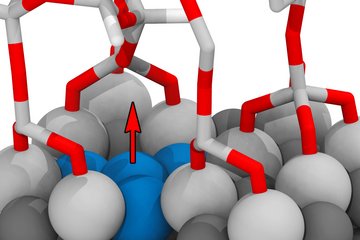All genres
1.
Journal Article
Ultrastrong and ductile CoNiMoAl medium-entropy alloys enabled by L12 nanoprecipitate-induced multiple deformation mechanisms. Journal of Materials Science & Technology 225, pp. 72 - 86 (2025)
2.
Journal Article
Compositive role of refractory element Mo in improving strength and ductility of face-centered-cubic complex concentrated alloys. Acta Materialia 255, 119030 (2023)
3.
Journal Article
Effect of solid-solution strengthening on deformation mechanisms and strain hardening in medium-entropy V1-xCrxCoNi alloys. Journal of Materials Science & Technology 108, pp. 270 - 280 (2022)
4.
Journal Article
Effects of Cr/Ni ratio on physical properties of Cr–Mn–Fe–Co–Ni high-entropy alloys. Acta Materialia 227, 117693 (2022)
5.
Journal Article
Chemically induced local lattice distortions versus structural phase transformations in compositionally complex alloys. npj Computational Materials 7 (1), 34 (2021)
6.
Journal Article
Effects of cryogenic temperature on tensile and impact properties in a medium-entropy VCoNi alloy. Journal of Materials Science & Technology 90, pp. 159 - 167 (2021)
7.
Journal Article
Element-resolved local lattice distortion in complex concentrated alloys: An observable signature of electronic effects. Acta Materialia 216, 117135 (2021)
8.
Journal Article
Finite-temperature interplay of structural stability, chemical complexity, and elastic properties of bcc multicomponent alloys from ab initio trained machine-learning potentials. Physical Review Materials 5 (7), 073801 (2021)
9.
Journal Article
Impact of N on the Stacking Fault Energy and Phase Stability of FCC CrMnFeCoNi: An Ab Initio Study. Journal of Phase Equilibria 42, pp. 551 - 560 (2021)
10.
Journal Article
Design of a dual-phase hcp-bcc high entropy alloy strengthened by ω nanoprecipitates in the Sc–Ti–Zr–Hf–Re system. Materials and Design 192, 108716 (2020)
11.
Journal Article
Combined Al and C alloying enables mechanism-oriented design of multi-principal element alloys: Ab initio calculations and experiments. Scripta Materialia 178, pp. 366 - 371 (2020)
12.
Journal Article
Role of magnetic ordering for the design of quinary TWIP-TRIP high entropy alloys. Physical Review Materials 4 (3), 033601 (2020)
13.
Journal Article
Correlation analysis of strongly fluctuating atomic volumes, charges, and stresses in body-centered cubic refractory high-entropy alloys. Physical Review Materials 4 (2), 023608 (2020)
14.
Journal Article
Dislocation-induced breakthrough of strength and ductility trade-off in a non-equiatomic high-entropy alloy. Acta Materialia 185, pp. 45 - 54 (2020)
15.
Journal Article
Frontiers in atomistic simulations of high entropy alloys. Journal of Applied Physics 128 (15), 150901 (2020)
16.
Journal Article
Ab initio vibrational free energies including anharmonicity for multicomponent alloys. npj Computational Materials 5 (1), 80 (2019)
17.
Journal Article
Impact of interstitial C on phase stability and stacking-fault energy of the CrMnFeCoNi high-entropy alloy. Physical Review Materials 3 (11), 113603 (2019)
18.
Journal Article
Invar effects in FeNiCo medium entropy alloys: From an Invar treasure map to alloy design. Intermetallics 111, 106520 (2019)
19.
Journal Article
Ultrastrong Medium‐Entropy Single‐Phase Alloys Designed via Severe Lattice Distortion. Advanced Materials 31, 1807142 (2019)
20.
Journal Article
Ab initio phase stabilities and mechanical properties of multicomponent alloys: A comprehensive review for high entropy alloys and compositionally complex alloys. Materials Characterization 147, pp. 464 - 511 (2019)











